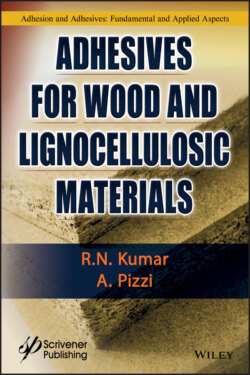Читать книгу Adhesives for Wood and Lignocellulosic Materials - R. N. Kumar - Страница 56
2.4.1.1 lllustration of Mechanical Adhesion for Wood
ОглавлениеIn wood adherends, there is a vast array of void spaces as shown in Figure 2.2. Spontaneous surface wetting and capillary effects allow the flow of the adhesive resin into the cell lumen, vessels, or other interstices followed by subsequent hardening of the resin and resulting in mechanical interlocking. The resin acts to reinforce the surface/interface layers of wood cells. An adhesive penetration of approximately 6–10 cell diameters (fewer than 100 μm, maximum) is regarded as necessary for optimal adhesive bonding. Filling the cell lumen with adhesive provides much larger mechanical interlocks than are available with surface roughness for other substrates. Absorption into the cell wall can provide micromechanical interlocks and interpenetrating networks [1].
Figure 2.2 Various wood elements.
